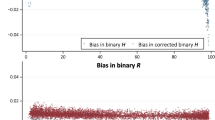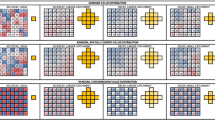Abstract
This paper uses data from a UK Census Rehearsal to explore the problem of small-area income estimation. First, the nature of the problem is revisited through an examination of the way in which incomes vary spatially. Residential rather than labour market sorting is found to be the dominant driver; and the rich are found to exhibit greater spatial segregation than the poor. Even so, location is shown to capture only a small fraction of the overall variation in incomes. Second, the performance of competing small-area estimation strategies is assessed, uniquely comparing proxy, geodemographic, imputation and model-based estimates; and validating all of these against directly observed values. An area-level model, ecological regression, performs best. Unit-record imputation approaches capture similar levels of spatial variation in mean income, but have higher variances and greater systematic biases. The same can be said of a simple univariate proxy (% professionals), which even so proves surprisingly effective.




Similar content being viewed by others
Notes
The fewer responses per spatial unit, and the fewer the income bands used to classify their incomes, the fewer available degrees of freedom there are, and the greater the ‘structural’ component of between-area income variation will be. This structural component can be estimated by randomly assigning responses (adult and household incomes) across spatial units, subject to matching the marginal constraints captured in the Census Rehearsal of the number of respondents per income band and the number of respondents per spatial unit, and then measuring the resulting between-area variation. The ‘structural’ variation is taken to be the 100-run average of such measures.
References
Anderson, B. (2013). Estimating small are income deprivation: an iterative proportional fitting approach, Chapter 4. In R. Tanton & K. L. Edwards (Eds.), Spatial microsimulation: a reference guide for users (pp. 49–68). London: Springer.
Berthoud. (2008). Area variations in household income across Great Britain. Cambridge Journal of Regions, Economy and Society, 1, 37–49.
Birkin, M., & Clarke, M. (1989). The generation of individual and household incomes at the small area level using SYNTHESIS. Regional Studies, 23(6), 535–548.
Birkin, M., & Clarke, G. (1995). Using microsimulation methods to synthesize census data. In S. Openshaw (Ed.), Census users’ handbook (pp. 363–387). Cambridge: GeoInformation International.
Bond, S., & Campos, C. (2010). Understanding income at small area level, Regional Trends 42 (pp. 80–94). London: Office for National Statistics.
Bramley, G., Lancaster, S., & Gordon, D. (2000). Benefit take-up and the geography of poverty in Scotland. Regional Studies, 34(6), 507–519.
CACI. (1999). Paycheck: Targeting by income. London: CACI.
Casarosa, M., Fierravanti, S., Colucci, A. et al. (2011). European policy brief: Small area methods for poverty and living condition estimates. SAMPLE Consortium. http://www.sample-project.eu/images/stories/policy_brief.pdf
Cloutier, N. R. (1997). Metropolitan income inequality during the 1980s: the impact of urban development, industrial mix, and family structure. Journal of Regional Science, 37(3), 459–478.
Collins et al. (undated) 2007 Census Test: the effects of including questions on income and implications for the 2011 Census, Office for National Statistics. http://www.ons.gov.uk/ons/guide-method/census/2011/the-2011-census/the-2011-census-project/2007-test/income-evaluation/index.html
Dale, A., Middleton, E., & Schofield, T. (1995). New earnings survey variables added to the SARs. SARs Newsletter 6, Census Microdata Unit, University of Manchester.
Daniel, E., & Bright, G. (2011). Exploring the geographical distribution of wealth using the output area classification. Economic and Labour Market Review 2011, 59–78.
Davies, H., Joshi, H., & Clarke, L. (1997). Is it cash the deprived are short of. Journal of the Royal Statistical Society A, 160(1), 107–126.
DCLG. (2011). The english indices of deprivation 2010. London: Dept. for Communities and Local Government.
Dorling. (1999). Who’s afraid of income inequality? Environment and Planning A, 31(4), 571–574.
Dorling, D., Rigby, J., Wheeler, B., et al. (2007). Poverty, wealth and place in Britain, 1968 to 2005. Bristol: The Policy Press.
Experian (2005). Household income – UK 2004 data profile. Experian. http://cdu.mimas.ac.uk/experian/household%20income.pdf [accessed 13/12/2011]
Famhy, E., Gordon, D., Dorling, D., et al. (2011). Poverty and place in Britain, 1968–99. Environment and Planning A, 43, 594–617.
Fry, R. (2011). Understanding household income poverty at small area level, Regional Trends 43 (pp. 1–16). London: Office for National Statistics.
Gibbons, S., Overman, H. G., & Pelkonen, P. (2010). Wage disparities in Britain: People or place? SERC Discussion Paper 60, Spatial Economics Research Centre, Dept. of Geography and Environment, London School of Economics.
Gonzalez, M. E., & Hoza, C. (1978). Small-area estimation with application to unemployment and housing estimates. Journal of the American Statistical Associationion, 73, 7–15.
Gordon, D., & Forrest, R. (1995). People and places 2: social and economic distinctions in England, Bristol: School for Advanced Urban Studies (SAUS).
Gordon, D., Adelman, L., Ashworth, K., et al. (2000). Poverty and social exclusion in Britain. York: Joseph Rowntree Foundation.
Green, A. (1994). The geography of poverty and wealth. Institute for Employment Research, University of Warwick.
Guangquan, L., Clarke, P., Taylor, A., Richardson, S., & Best, N. (2011). Improving small area estimates of income using Bayesian hierarchical models with heteroscedastic sampling error variances. Poster presented at the Small Area Estimation conference at Trier, Germany (11–13, 2011).
Heady, P., & Ralphs, M. (2004). Some findings of the EURAREA project – and their implications for statistical policy. Statistics in Transition, 6(5), 641–653.
Jargowsky. (1996). Take the money and run: economic segregation in U.S. Metropolitan Areas. American Sociological Review, 61(6), 984–998.
Lee, P., Murie, A., & Gordon, D. (1995). Area measures of deprivation: a study of current best practices in the identification of poor areas in Great Britain, Centre for Urban and Regional Studies, University of Birmingham.
Lehtonen, R., Veijanen, A., Myrskylä, M., & Valaste, M. (2011) Small area estimation of indicators on poverty and social exclusion, Deliverable 2.2, AMELI Advanced Methodology for European Laeken Indicators.
Longhurst, J., Cruddas, M., Goldring, S., & Mitchell, B. (2004a). Model-based estimates of income for wards, 1998/99: Technical Report. Titchfield: Office for National Statistics.
Longhurst, J., Cruddas, M., Goldring, S., & Mitchell, B. (2004b). Model-based estimates of income for wards, 1998/99: Validation Report. Titchfield: Office for National Statistics.
McCulloch, A. (2001). Ward level deprivation and individual social and economic outcomes in the British Household Panel Study. Environment and Planning A, 33(4), 667–684.
Micklewright, J., & Schnepf, S. V. (2010). How reliable are income data collected with a single question? Journal of the Royal Statistical Society A, 173(2), 409–429.
Mitchell, R. (2001). Multilevel modelling might not be the answer. Environment and Planning A, 33(8), 1357–1360.
Moss, C. (1999). Selection of topics and questions for the 2001 Census. Population Trends, 97, 28–36.
National Research Council. (2000). Small-area income and poverty estimates: priorities for 2000 and beyond, Panel on estimates of poverty for small geographic areas. In C. F. Citro & G. Kalton (Eds.), Committee on national statistics. Washington D.C: National Academy Press.
ONS (2006). The 2011 Census: Assessment of initial user requirements on content for England and Wales – Income, Information Paper. Titchfield: Office for National Statistics. http://www.ons.gov.uk/ons/about-ons/consultations/closed-consultations/2006/2011-census---responses/response-to-consultation---2011-census.pdf
ONS (2013). Beyond 2011: Producing socio-demographic statistics 2. M12 Methods & Policies. Titchfield: Office for National Statistics.
Openshaw, S., & Wymer, C. (1995). Classifying and regionalizing census data. In S. Openshaw (Ed.), Census users’ handbook (pp. 239–270). Cambridge: GeoInformation International.
Rao, J. N. K. (2003). Small area estimation. Hoboken: Wiley.
Rees, P. H. (1998). What do you want from the 2001 Census? Results of an ESRC/JISC survey of user views. Environment and Planning A, 30, 1775–1796.
The EURAREA Consortium (2004). Project Reference Volume, Enhancing small area estimation techniques to meet European needs, Deliverable D7.1.4. http://www.ons.gov.uk/ons/guide-method/method-quality/general-methodology/spatial-analysis-and-modelling/eurarea/downloads/project-reference-volume--volume-one--main-report.pdf
Tunstall, R. (2005). Using the US and UK Censuses for comparative research. Discussion Paper prepared for the Brookings Institution Metropolitan Policy Program, STICERD, London School of Economics. http://sticerd.lse.ac.uk/dps/case/CBIR/Using_US_and_UK_Censuses.pdf
Tzavidis, N., Salvati, N., Pratesi, M., & Chambers, R. (2008). M-quantile models with applications to poverty mapping. Statistical Methods and Applications, 17, 393–411.
Tzavidis, N., Marchetti, S., & Chambers, R. (2010). Robust estimatin of small-area means and quantiles. Australian and New Zealand Journal of Statistics, 2, 167–186.
Vickers, D., & Rees, P. H. (2006). Introducing the area classification of output areas. Population Trends, 125(3), 15–24.
Voas, D., & Williamson, P. (2000). The scale of dissimilarity: concepts, measurement and an application to socio-economic variation across England and Wales. Transactions of the Institute of British Geographers, 25, 465–481.
Voas, D., & Williamson, P. (2001). The diversity of diversity: a critique of the geodemographic classification. Area, 33(1), 63–76.
White, N., Dent, A., Clarke, P., Silva, D., & Naylor, J. (2009). Model-based estimates of income for middle super output areas, 2007/08: Technical Report. London: Office for National Statistics.
Wilkinson, R., & Pickett, K. (2009). The spirit level: why more equal societies almost always do better. London: Allen Lane.
Acknowledgments
The research reported here arose from the ESRC-funded project ‘Income imputation for small areas’, award no. H507255166. Grateful thanks are due to the Census Custodians of England, Wales and Scotland for granting permission to access the Census Rehearsal dataset. A debt of gratitude is owed to a number of staff at the Office for National Statistics, in particular Keith Whitfield and Philip Clarke. Thanks are also due to David Voas for undertaking some of the preparatory work for this project. The Family Resources Survey, 1998, used to derive mean values for income bands, was sponsored and collected by the Department for Social Security, and supplied for research use by the UK Data Archive. Thanks also to two anonymous reviewers for their perceptive comments. All analyses and conclusions remain the sole responsibility of the author.
Author information
Authors and Affiliations
Corresponding author
Rights and permissions
About this article
Cite this article
Williamson, P. Small-Area Incomes: Their Spatial Variability and the Relative Efficacy of Proxy, Geodemographic, Imputed and Model-Based Estimates. Appl. Spatial Analysis 9, 463–489 (2016). https://doi.org/10.1007/s12061-015-9163-1
Received:
Accepted:
Published:
Issue Date:
DOI: https://doi.org/10.1007/s12061-015-9163-1




